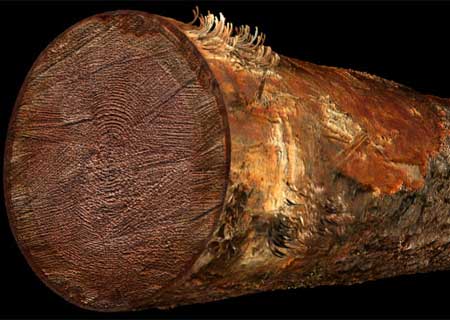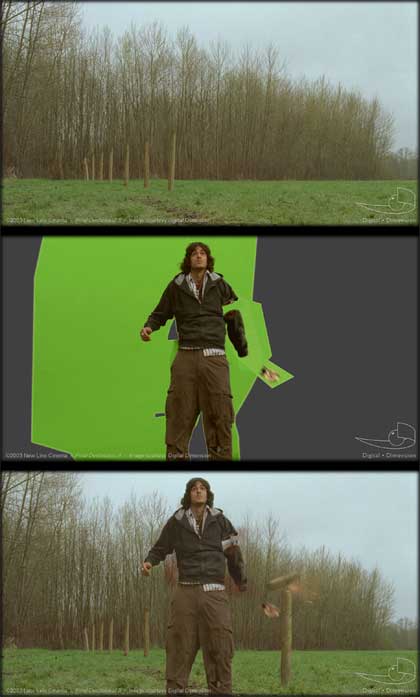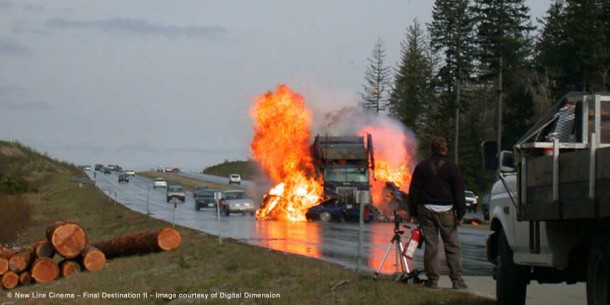Interview with Jason Crosby: Final Destination 2
Interview with Jason Crosby
CG Supervisor at Digital Dimension
JEH: Digital Dimension have grown quiet a reputation in the industry. Three Emmy Awards, tons of film and television credits. What do you think was the key factor in Digital Dimension getting this work on Final Destination II?
JC: A large part of the effects needed for the film involved logs. I think it was our outstanding ability to create and model long primitive cylinders that really landed us the gig ;). Seriously, when New Line started shooting the major accident in Vancouver they discovered that real logs only bounced about an inch off the road when dropped from a logging truck. Obviously this didn’t have the impact they wanted for a Hollywood style crash scene. They were concerned about how they would make the shot happen, not knowing if CG would work. The timing was great because we had just finished a test shot of our CG logs bouncing on the freeway. We sent a tape to Vancouver and after seeing it the crew was convinced that any of the log shots could be done with CG.
(Disclaimer: this video contains scenes of extreme gore)
JEH: What are the key shots you guys did for that film?
JC: The opening highway crash sequence at the open of the movie took the longest, partly because it has so many shots. There were also many other premonitions and other death sequences we were involved with. See our website gallery (www.digitaldimension.com) for a more detailed behind-the-scenes of the FX sequence.
EH: It seems the marquee shot your people did is the “Log Sequence”. This is extremely complex, why don’t you begin by breaking down the work you guys had to do on this?
JC: It began with R&D on the log dynamics. Scripts were written to help manage the dynamic simulations. I started running simulations with real world numbers for gravity, density, etc. The results were remarkably similar to the original logs shot in Vancouver. This was a testament to the accuracy of the software and the data we had collected, however the logs still lacked the “jumping through windshields killer instinct” we were looking for. By tweaking the parameters we coaxed the logs into a much livelier role.

The digital log rendered in 3ds max…
A shot will always fall apart no matter how good a 3D element looks if it isn’t accurately tracked into the plate. James Coulter, Sr. Technical Director, did some creative 3D tracking on shots with fast pans and huge amounts of motion blur. Next, we needed particle systems for dust, dirt, chunks of bark and other debris. These were a lot of fun because they were rule based systems that would emit in certain ways depending on the actions of the logs. Every time a new log simulation was run we got to see the particles emit while it was running.
Finally there were lots of other fillers like mist from the road, large slabs of bark, broken chains and miscellaneous things added to the shot. Also many layers were generated for the compositors like height and depth maps as well as the traditional render passes.
JEH: The logs themselves are extremely impressive considering they are CG. How did you manage to get such realism (both the texture and the physics)?
JC: The textures from the logs mostly came from a collection of high res photos that were taken on set and then carefully stitched together. Edmund Kozin did a lot of work manipulating these images to give us true 3D displacement, bump, specular and diffuse maps for 22 unique logs. Scale was very important in the textures, if we had a photograph that covered two feet of a log he made sure that in the final texture that photograph would only be mapped onto two feet of our CG log.
The physics were a matter of collecting lots of data and setting it all up in the simulator. Things like speed and height of the logging truck, length and width of the logs, type of wood and eventually the density of a Douglas Fir, it’s 522 kg/m3 just in case you were wondering. Then we tweaked the parameters and basically cranked out loads of simulations for the Visual Effects Supervisor and Director to choose from.
JEH: Can you tell us about the rendering tools or shaders you used for the logs?
JC: In addition to the diffuse, bump, specular and displacement maps, hair shaders were also used. This helped to add the splintering and frayed wood look that displacement couldn’t give us. I’m always amazed at the number of uses people are finding for hair shaders. The web from Spiderman’s wrist was a great example of that.
When it came time to render we used Global Illumination and image based lighting from the plates and HDR reference photos we had taken on the set. That meant the elements 3D guys gave to the compositors were already in a pretty good ballpark as far as color and lighting.
JEH: You also built a very strong reputation for making CG Cars (In Driven, it was virtually impossible to distinguish CG cars from the real ones). Did you have to create any CG cars in this sequence?
JC: It was a possibility in the beginning so we did some dynamics tests using the logs as rigid bodies to hit cars with soft body deformers on them. Crushing cars was fun R&D but when they were done shooting they didn’t end up needing any CG cars.
JEH: What was the most difficult in bringing this all together into a finished shot? (Compositing, shadows, particles, etc…).
JC: One of the most challenging aspects of the sequence was the fact that it was shot over the course of many days at different times. When it came together it had to appear as though it all took place in a matter of minutes. Our Lead Compositor Leandro Visconti did a great job of blending the CG into each individual shot while maintaining color and light consistency throughout the sequence.
JEH: There is a sequence where you have to “Slice” a character into several pieces. How was this achieved?
JC: We were given different plates of a character being sliced so a lot of that sequence involved putting the stuff together in comp and adding little things like CG spurts of blood. There were some neat dynamics done by Brandon Davis where CG fence posts flew threw the air held together by barbwire.
(Disclaimer: this video contains scenes of extreme gore)
JEH: Looking back, what was your favorite moment of the whole experience?
JC: I really enjoyed creating automated particle systems that responded in real time to the dynamics. Once the system was in place it was pretty much a matter of pressing the simulate button and watching logs, dust, dirt and debris create their own animation. Obviously it was a lot of work to get to that point.
JC: What’s next in your pipeline?
JEH: We were working on a new reality series where a woman marries a chimp but it was canned due to a copyright infringement 😉 No, seriously, we just finished work on Cradle 2 the Grave, starring Jet Li and are currently working on a film called Torque as well as a few broadcast projects and a game cinematic.
Thanks for the interview, we love CG Channel. Keep up the good work!
JEH: Many thanks to Ben Girard for making this story possible! Keep up the good work!
Related Links:


